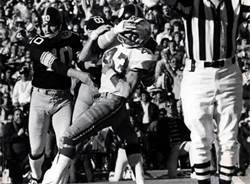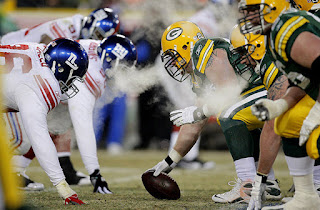The San Francisco 49ers met the
Cincinnati Bengals in another Super Bowl and this one wouldn’t be decided until
the final minute. After a back-and-forth game, the Bengals held a 16-13 lead
with just over three minutes left in the fourth quarter. The 49ers had
possession of the ball on their own eight-yard line.
Forty-niner quarterback, Joe
Montana completed three short passes and runningback, Roger Craig carried twice,
enabling San Francisco to pick up a few first downs. Then Montana connected with
receiver, Jerry Rice, for 17 yards to move the ball to the Cincinnati 48. After
an incomplete pass and an offensive penalty, the 49ers faced second-and-20 from
their own 45 with only 1:15 left to play.
Rice caught a pass at the Bengal
33, avoided three Cincinnati defenders, and was finally brought down on the
18-yard line. An eight-yard pass to Craig, brought up second-and-two from the
ten, with 39 seconds to play. Montana then finished the game-winning drive with
a pass to receiver, John Taylor, who caught the ball in the end zone. After the
extra point, the score was 20-16. The 49er defense held Cincinnati at bay for
the remaining thirty seconds and the 49ers had their third Super Bowl victory.
Who could ever forget Super Bowl
25? The third-and-long reception of New York Giant receiver, Mark Ingram. Or
Buffalo Bills’ running back, Thurman Thomas's long touchdown run. Or the fact that
the Giants’ offense held possession of the ball for over 40 minutes, a Super
Bowl record. Or the wide-right missed field goal of Bills’ kicker, Scott
Norwood.
But the most memorable moment of
Super Bowl 25 happened before the game. It was Grammy-Award winner Whitney
Houston’s incredible performance in singing the Star-Spangled Banner. The
United States was at war with Iraq (The First Gulf War) and patriotic fever was
in the air. With heightened security and suggestions that maybe the game shouldn’t even be
played, the stadium in Tampa Bay was a sea of American Flags as the fans showed
their support for the troops fighting in the Middle East.
And Whitney’s performance of the
National Anthem gave everyone goosebumps and sent shivers down spines. It was
such an amazing rendition, it was even released as a single that reached Number
20 on the U.S. charts.
The Dallas Cowboys were making
their first Super Bowl appearance in 14 years, while the Buffalo Bills were in
the big game for the third year in a row. This game was close for about the
first quarter when Dallas led 14-7 going into the second. After Bills’ starting
quarterback, Jim Kelly, injured his knee and was taken out of the game,
numerous Buffalo turnovers led to numerous Cowboy touchdowns and Dallas easily
won the game, 52-17.
However, the Cowboys could have
scored even more points if it wasn’t for the idiocy of defensive tackle, Leon
Lett. With Dallas having already scored 52 points, they appeared headed towards
the record that had been set in Super Bowl 24 by the San Francisco 49ers (55).
Bills’ back-up quarterback, Frank Reich, dropped
back to pass, but was hit by Jim Jeffcoat, causing a fumble. Lett quickly moved
in and scooped up the loose ball at the Cowboys’ 36-yard line and appeared to
be heading for a touchdown as there was nobody between him and goal line.
Buffalo wide receiver, Don Beebe, gave chase and was quickly closing the gap.
Had Lett continued to hustle and run, he would have scored. Instead he slowed
down and started to showboat, holding the ball out at his side. Beebe caught
him and swatted the ball out of his hands before he crossed the goal line. The
ball bounced harmlessly through the end zone for a touch back, giving the Bills
the ball back.
Instead of scoring a touchdown,
Lett looked like the biggest goof in Super Bowl history.
Ever since Steve Young became
the number one quarterback of the San Francisco 49ers in 1991, the comparisons
with Joe Montana never ceased. The pressure became more and more intense as the
Niners lost the NFC Championship game two years in a row to the Dallas Cowboys
in 1992 and 1993. However, in 1994, San Fran finally managed to beat Dallas and
would face the San Diego Chargers in Super Bowl 29.
The game wasn’t close as San
Fran walloped the Chargers 49-26. The scoring started early. On the third play
of the game, Young threw a 44-yard touchdown pass to Jerry Rice. On their next
possession, Young threw a 51-yard touchdown pass to Rickey Watters. In the second
quarter, he threw his third TD pass of the game, a short five-yard play to
William Floyd. Before the half had ended, Young threw his fourth TD pass,
another Watters score, this time from eight yards out.
After Watters scored a TD on a
running play, Young tied Montana’s Super Bowl record for TD passes in a game
when he hit Rice on a 15-yard pass. Finally, in the fourth quarter, Young broke
the record when he hit Rice on a seven-yard pass for the receiver’s third TD
catch, and Young’s sixth TD pass.
The 49er quarterback was named
the game’s Most Valuable Player and late in the fourth quarter, asked for
someone to remove the “monkey from off his back” in a reference to playing
under Montana’s shadow. Rather foolishly, 49er linebacker Gary Plummer, removed
an imaginary monkey from Young’s back, an act that looked pretty silly and
Young, years later, would admit to having some regret over that moment of the
game.
However, Young’s performance in the Super Bowl, proved he could win the big one, and solidified him as one of the best
quarterbacks of the era.
Follow us on Twitter at @topofthethird






























